There’s nothing quite like biting into a juicy, ripe tomato fresh from your garden. Homegrown tomatoes are not only delicious, but they’re also a money-saving delight, perfect for fresh-eating and preserving. With endless colors, shapes, and sizes to choose from, growing tomatoes at home can be a rewarding experience for any gardener.
This guide is designed to walk you through the process of cultivating these tasty fruits, from selecting the right variety to harvesting your crop. Whether you’re a seasoned gardener or just starting out, you’ll find the journey of growing your own tomatoes to be both fun and fulfilling.
Key Takeaways
- Learn how to choose the right tomato variety for your garden.
- Understand the basics of soil preparation for optimal tomato growth.
- Discover tips for nurturing your tomato plants to maximize yield.
- Find out how to protect your tomatoes from common pests and diseases.
- Get insights into the best practices for harvesting homegrown tomatoes.
The Joy and Benefits of Growing Tomatoes at Home
There’s something special about biting into a sun-ripened tomato from your own garden. The experience is not just about the taste; it’s also about the numerous benefits that come with growing your own tomatoes.
Superior Flavor and Nutritional Value
Homegrown tomatoes are known for their superior flavor and higher nutritional value compared to store-bought tomatoes. This is because they are allowed to ripen on the vine, enhancing their flavor and nutrient content.
Economic Benefits and Food Security
Growing your own tomatoes can lead to significant economic savings. By having a steady supply of homegrown tomatoes, you reduce your reliance on grocery stores, thereby saving money. Moreover, having a home garden contributes to food security by providing a consistent supply of fresh produce.
Therapeutic Aspects of Tomato Gardening
Gardening, including growing tomatoes, is known to have therapeutic benefits. It can help reduce stress and improve mental health. The act of nurturing plants and watching them grow can be very fulfilling.
| Benefits | Description |
|---|---|
| Superior Flavor | Homegrown tomatoes have a richer taste due to being vine-ripened. |
| Economic Savings | Growing your own tomatoes reduces grocery bills. |
| Therapeutic Benefits | Gardening can reduce stress and improve mental well-being. |
Selecting the Best Tomato Varieties for Home Gardens
Selecting the ideal tomato variety for your home garden involves considering several important factors, including the space available, the desired flavor profile, and the level of disease resistance you need.
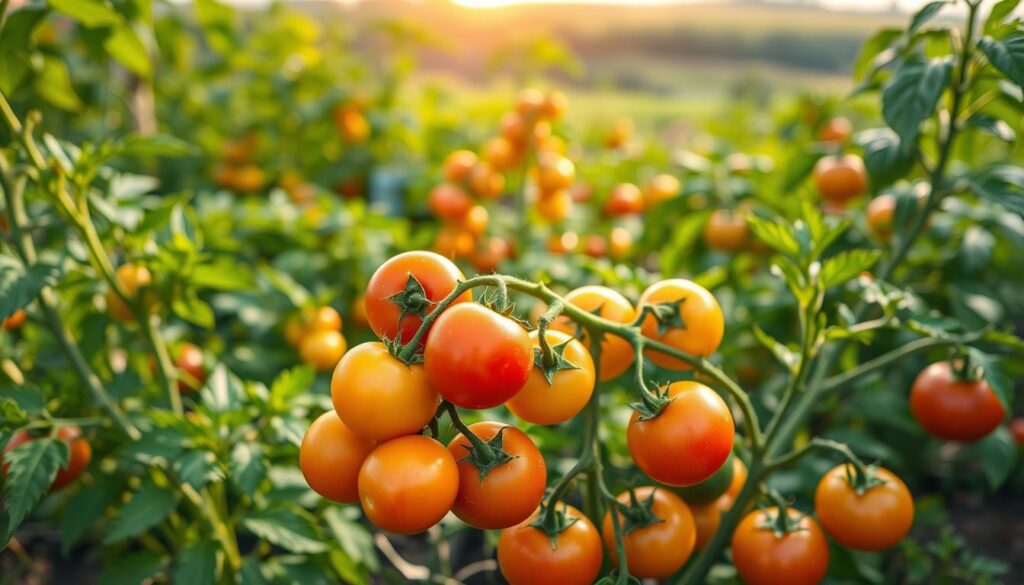
Determinate vs. Indeterminate: Which Type Fits Your Space
Tomato varieties are broadly classified into determinate and indeterminate types. Determinate tomatoes are compact, bushy, and produce fruit all at once, making them ideal for smaller gardens or containers. Indeterminate tomatoes, on the other hand, are vining, require support, and produce fruit throughout the season, suiting larger gardens with trellises or cages.
Heirloom Varieties: Flavor Champions
Heirloom tomatoes are prized for their unique flavors and textures. They come in a variety of colors and patterns, adding visual appeal to your garden and culinary dishes.
Hybrid Varieties: Disease Resistance and Productivity
Hybrid tomato varieties offer improved disease resistance and higher yields, making them a popular choice among gardeners seeking reliability and productivity.
Cherry, Roma, and Beefsteak: Purpose-Based Selection
Different tomato varieties serve different purposes. Cherry tomatoes are great for snacking, Roma tomatoes are ideal for canning, and Beefsteak tomatoes are perfect for slicing. Choosing the right type based on your intended use can enhance your gardening experience.
Essential Supplies and Setup for Tomato Success
To grow delicious tomatoes at home, it’s crucial to start with the right supplies and setup. Tomatoes require specific conditions to thrive, and having the appropriate equipment is key to a successful harvest.
Soil Requirements and Container Options
Tomatoes need rich, well-drained soil to grow well. If you’re growing in containers, choose pots that are at least 12 inches in diameter to provide enough room for the roots to develop. Good soil quality is essential for healthy tomato plants.
When selecting containers, ensure they have drainage holes to prevent waterlogged soil. You can also use self-watering containers to help manage moisture levels.
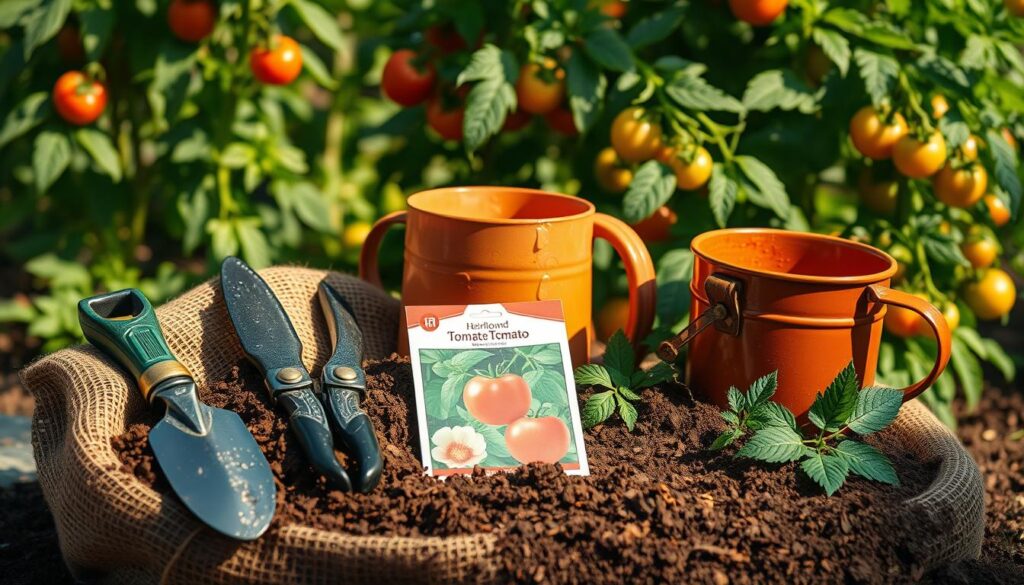
Support Systems: Stakes, Cages, and Trellises
Tomato plants need support as they grow. There are several options available, including stakes, cages, and trellises. Stakes are ideal for indeterminate varieties, while cages can support both determinate and indeterminate types.
Trellises offer another effective way to train your tomato plants to grow vertically, maximizing space in your garden.
Tools and Equipment Checklist
Having the right tools on hand can make tomato gardening easier. Essential items include a trowel, watering can, pruning shears, and a soil test kit. These tomato gardening tips will help you prepare for a successful growing season.
By following these steps to grow tomatoes at home and having the right supplies, you’ll be well on your way to enjoying a bountiful harvest.
Starting Tomatoes from Seeds: Indoor Techniques
To get a head start on the growing season, many gardeners begin by starting tomatoes from seeds indoors. This approach allows for a longer growing season and gives plants a strong foundation for success.
Timing Your Indoor Seed Starting
Start tomatoes from seed 6-8 weeks before the last frost date in your area. This timing ensures that seedlings are ready to be transplanted outside when the weather warms up.
Step-by-Step Seed Starting Process
Begin by filling seed trays or small pots with a seed starting mix. Plant seeds at the recommended depth, usually ¼ inch. Keep the soil warm until germination occurs.
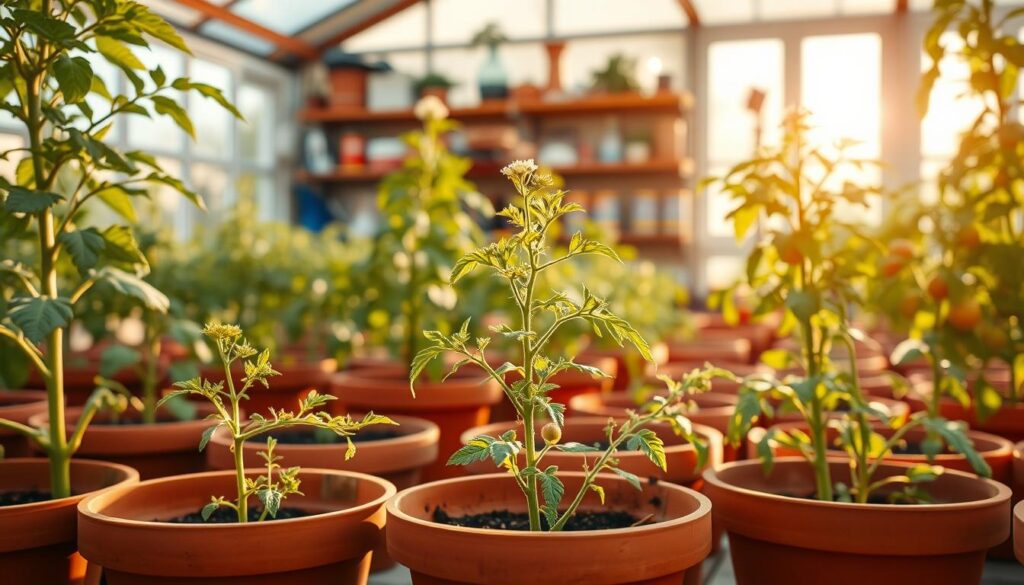
Caring for Seedlings: Light, Water, and Temperature
Seedlings require adequate light, consistent watering, and a warm temperature. Ensure they receive sufficient light, either from a sunny window or grow lights, and maintain a temperature around 70-80°F.
Common Seedling Problems and Solutions
Common issues include leggy seedlings due to insufficient light and damping off caused by overwatering. To prevent these problems, provide adequate light and water carefully.
By following these indoor techniques, you’ll be well on your way to growing delicious tomatoes at home, learning how to grow tomatoes indoors effectively.
Preparing Your Garden for Tomato Plants
Tomato gardening begins with preparing the right conditions in your garden. To grow healthy and productive tomato plants, you need to ensure that your garden provides the optimal environment.
Selecting the Optimal Growing Location
Tomatoes need full sun to produce a bountiful harvest, so choose a location that receives at least 6 hours of direct sunlight daily. Additionally, ensure good air circulation around the plants to prevent disease.
Soil Testing and Amendment
Test your soil to determine its pH and nutrient levels. Tomatoes prefer well-draining, fertile soil with a pH between 6.0 and 6.8. Based on your soil test results, amend the soil with organic matter like compost to improve its structure and fertility.
Bed Preparation and Spacing Guidelines
Prepare your garden bed by loosening the soil to a depth of 8-10 inches. Space tomato plants 18-36 inches apart, depending on the variety, to allow for good air circulation and easy access for maintenance.
By following these steps, you’ll be well on your way to a successful backyard tomato growing experience, setting the stage for a bountiful harvest.
Transplanting Seedlings to Your Outdoor Garden
Transplanting seedlings outdoors is a crucial step in growing delicious tomatoes at home. This process requires careful planning and attention to detail to ensure the successful transition of your tomato seedlings from indoor conditions to the outdoor garden.
Timing: When It’s Safe to Move Plants Outdoors
The key to successful transplanting is timing. It’s essential to wait until the soil has warmed up and the risk of frost has passed. Typically, this is when the daytime temperatures are consistently warm, and nighttime temperatures are above 55°F (13°C).
The Hardening Off Process
Before transplanting, seedlings need to be hardened off. This involves gradually exposing them to outdoor conditions over the course of 7-10 days. Start by moving them to a shaded outdoor area for a few hours a day, gradually increasing the duration and exposure to direct sunlight.

Deep Planting Technique for Stronger Roots
When transplanting, use the deep planting technique. Bury the seedling up to its first true leaves. This method encourages the development of a stronger root system, which is vital for tomato gardening tips and achieving a bountiful harvest.
Initial Care After Transplanting
After transplanting, ensure the soil is kept consistently moist but not waterlogged. Provide support if necessary, and keep an eye out for signs of stress or disease. With proper care, your tomato seedlings will thrive in their new outdoor environment.
How to Grow Tomatoes Indoors Year-Round
With the right conditions and care, you can enjoy a bountiful harvest of tomatoes from the comfort of your own home, 365 days a year. Growing tomatoes indoors requires attention to several key factors, including lighting, container selection, temperature, and pollination.
Lighting Requirements and Solutions
Tomatoes need a lot of light to grow indoors. If natural light is insufficient, consider using grow lights to supplement the lighting. LED grow lights are a popular choice due to their energy efficiency and ability to emit specific spectra that promote plant growth.
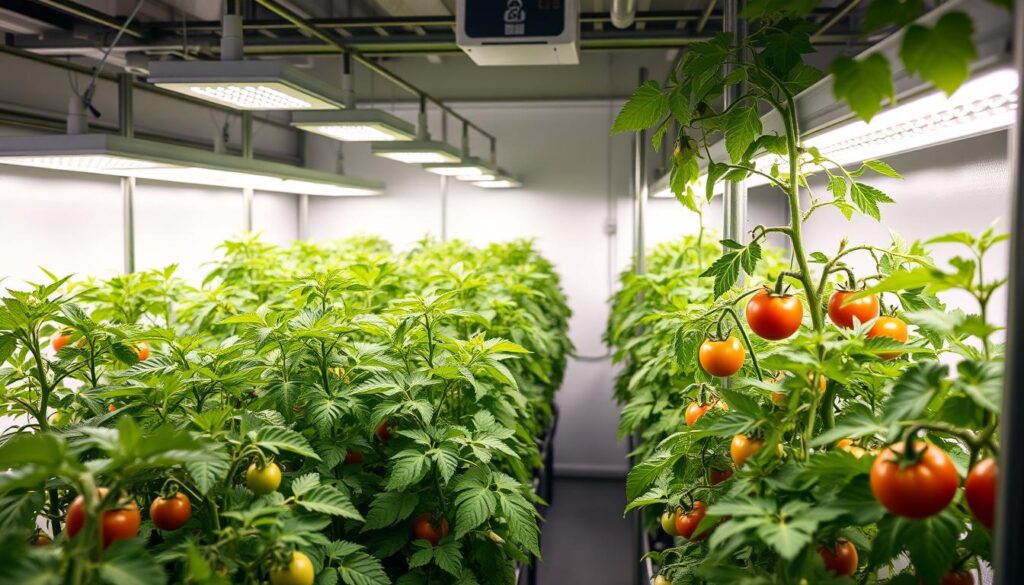
Container Selection and Specialized Soil Mixes
Choose containers that are at least 5-gallons to provide enough room for the roots to grow. Use a specialized soil mix designed for indoor plants, which typically contains ingredients like peat moss and perlite for improved drainage and aeration.
Temperature and Humidity Control
Maintain a consistent temperature between 65-70°F (18-21°C) during the day and around 55-60°F (13-15°C) at night. Tomatoes also benefit from a relatively high humidity, around 50-60%. You can use a humidifier if necessary.
Hand Pollination Techniques
Indoor tomato plants often require assistance with pollination. Gently vibrate the plants or use a small, clean brush to transfer pollen from the anthers to the stigma. This process mimics the natural pollination process that occurs outdoors.
| Factor | Requirement | Solution |
|---|---|---|
| Lighting | Adequate light for growth | Natural light or LED grow lights |
| Container | Enough space for root growth | 5-gallon or larger containers |
| Temperature | Consistent day and night temps | 65-70°F day, 55-60°F night |
| Pollination | Assistance with pollen transfer | Hand pollination techniques |
Organic Tomato Cultivation Methods
The shift towards organic tomato cultivation is driven by the desire for healthier produce and a more sustainable gardening practice. This approach focuses on nurturing the soil, reducing chemical use, and promoting eco-friendly techniques.
Natural Soil Enrichment Strategies
Enriching the soil naturally is fundamental to organic tomato cultivation. Using compost and natural amendments like manure or green manure can significantly enhance soil fertility and structure. These practices encourage beneficial microbial activity, which is crucial for healthy plant growth.
Companion Planting for Pest Management
Companion planting is a clever strategy for managing pests without resorting to chemicals. Plants like basil, marigold, and nasturtium repel pests that target tomatoes, while others, such as borage, attract beneficial insects. This method not only reduces pest damage but also adds biodiversity to your garden.
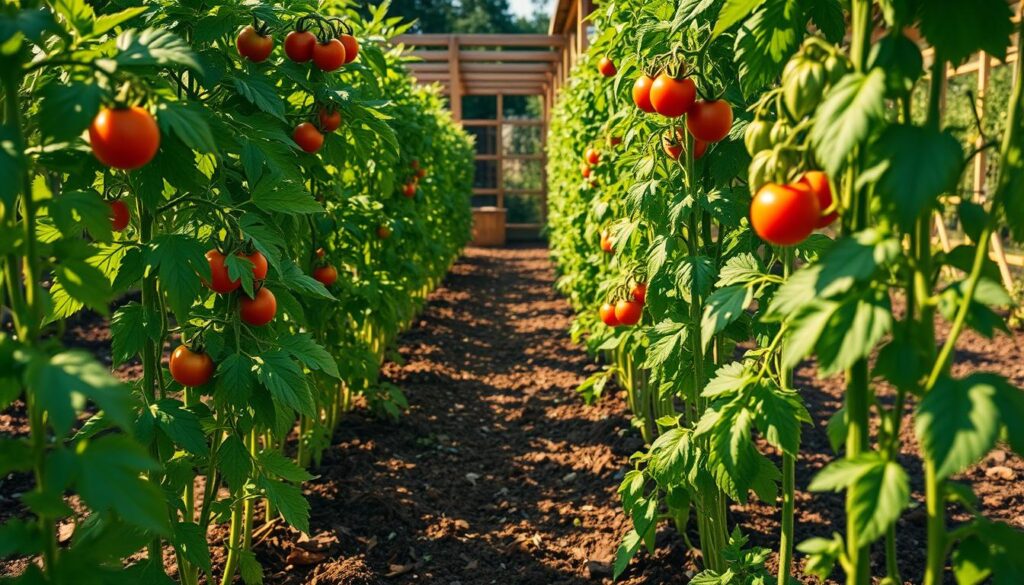
Organic Mulching Techniques
Organic mulching helps retain soil moisture, suppress weeds, and regulate soil temperature. Materials like straw, grass clippings, or wood chips are effective for mulching around tomato plants. As these materials decompose, they also add organic matter to the soil, further enriching it.
Chemical-Free Pest and Disease Control
Managing pests and diseases without chemicals is a cornerstone of organic tomato cultivation. Techniques include using neem oil, introducing beneficial insects, and practicing crop rotation. These methods help maintain a balanced ecosystem and prevent the development of pesticide-resistant pests.
Watering and Feeding Your Tomato Plants
To grow delicious tomatoes at home, it’s essential to understand their watering and feeding needs. Tomato plants require consistent moisture, especially when they’re fruiting. A well-planned watering schedule is crucial for healthy growth and a bountiful harvest.
Establishing an Effective Watering Schedule
Tomatoes need about 1-2 inches of water per week, either from rainfall or irrigation. It’s best to water them deeply once or twice a week, rather than lightly every day. This encourages deep root growth, making the plants more resistant to drought.
Drip Irrigation vs. Hand Watering
Drip irrigation is a highly efficient method for watering tomatoes. It delivers water directly to the roots, reducing evaporation and runoff. Hand watering can also be effective if done carefully, ensuring that the soil is moist but not waterlogged.
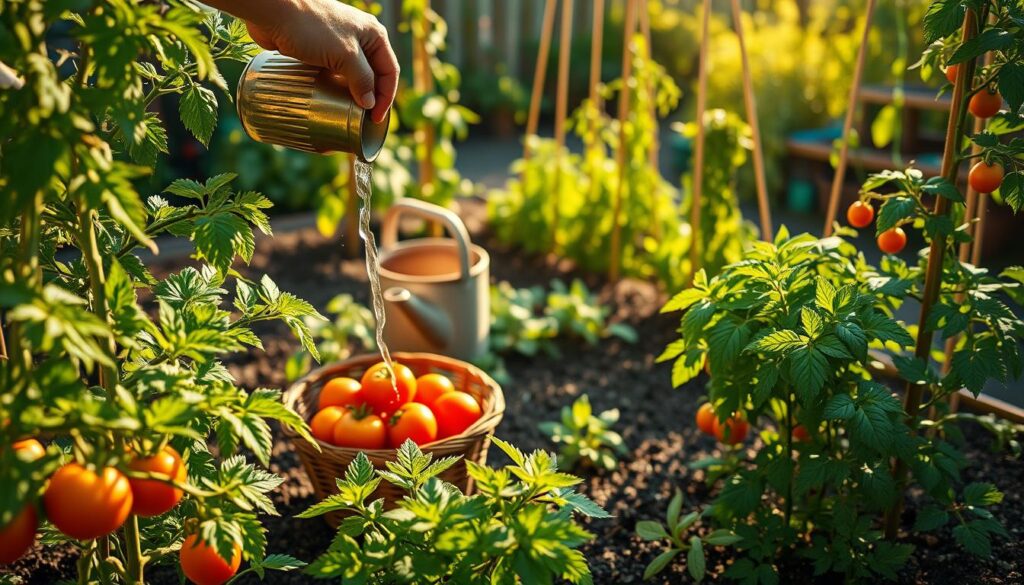
Organic vs. Synthetic Fertilizers
When it comes to feeding your tomato plants, you can choose between organic and synthetic fertilizers. Organic options like compost and manure tea provide a slow release of nutrients, improving soil health. Synthetic fertilizers offer a quick boost but may harm beneficial soil organisms if overused.
Signs of Nutrient Deficiencies and Solutions
Tomato plants can suffer from various nutrient deficiencies, such as nitrogen, phosphorus, or potassium deficiency. Signs include yellowing leaves, poor fruiting, or stunted growth. Using a balanced fertilizer and monitoring soil health can help prevent these issues.
| Nutrient | Deficiency Signs | Solution |
|---|---|---|
| Nitrogen | Yellowing leaves | Apply nitrogen-rich fertilizer |
| Phosphorus | Poor fruiting | Use a balanced fertilizer with phosphorus |
| Potassium | Weakened plant structure | Add potassium-rich organic matter |
By understanding and implementing proper watering and feeding techniques, you can significantly improve your tomato yield and enjoy a successful harvest.
Pruning and Training for Maximum Yield
The art of pruning and training tomato plants is essential for achieving a bountiful harvest in your home garden. By adopting the right techniques, you can significantly enhance the productivity of your plants.
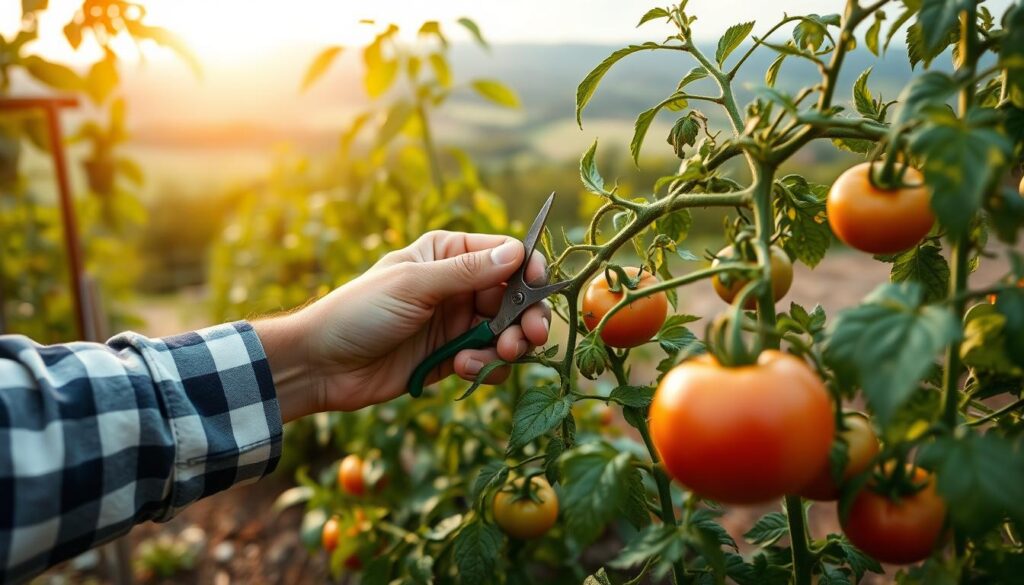
When and How to Remove Suckers
One of the critical steps in pruning your tomato plants involves removing suckers, which are the shoots that grow between the main stem and a branch. Removing these suckers helps to direct the plant’s energy towards fruiting, rather than vegetative growth. It’s best to remove suckers when they are still small, as this causes less stress to the plant.
Pruning Methods for Different Tomato Types
Different types of tomatoes require different pruning approaches. For indeterminate tomatoes, which continue to grow throughout the season, regular pruning is crucial to promote healthy growth and maximize yield. Determinate tomatoes, on the other hand, require less pruning as they grow to a certain height and then stop.
Training Systems for Vertical Growth
Training your tomato plants to grow vertically can be an effective way to make the most of your space, especially in smaller gardens. Using supports like trellises or stakes, you can train your plants to grow upwards. This not only saves space but also helps to improve air circulation around the plants, reducing the risk of disease.
Leaf Management for Disease Prevention
Effective leaf management is crucial for preventing disease in your tomato plants. Removing lower leaves can help prevent soil-borne diseases from splashing up onto the plant. It’s also a good practice to remove any leaves that show signs of disease to prevent it from spreading to other parts of the plant.
By implementing these pruning and training techniques, you can significantly improve the health and productivity of your tomato plants, leading to a more bountiful harvest in your backyard tomato growing endeavors. Following these steps to grow tomatoes at home will help ensure a successful and rewarding experience.
Troubleshooting Common Backyard Tomato Growing Challenges
The path to a bountiful tomato harvest is often paved with challenges that need to be addressed. Whether you’re a seasoned gardener or just starting out, understanding how to identify and solve common problems is crucial for success in tomato gardening.
Identifying and Managing Tomato Pests
Regular inspection is key to managing pests. Common pests include tomato hornworms and flea beetles. To control these pests organically, consider using neem oil or introducing beneficial insects to your garden.
- Inspect plants regularly for signs of pests.
- Use organic pest control methods whenever possible.
- Encourage beneficial insects in your garden.
Recognizing and Treating Common Diseases
Diseases can significantly impact tomato yields. Common diseases include fungal infections, bacterial spot, and viral diseases. Practicing good garden hygiene, such as removing infected plants and rotating crops, can help prevent the spread of disease.
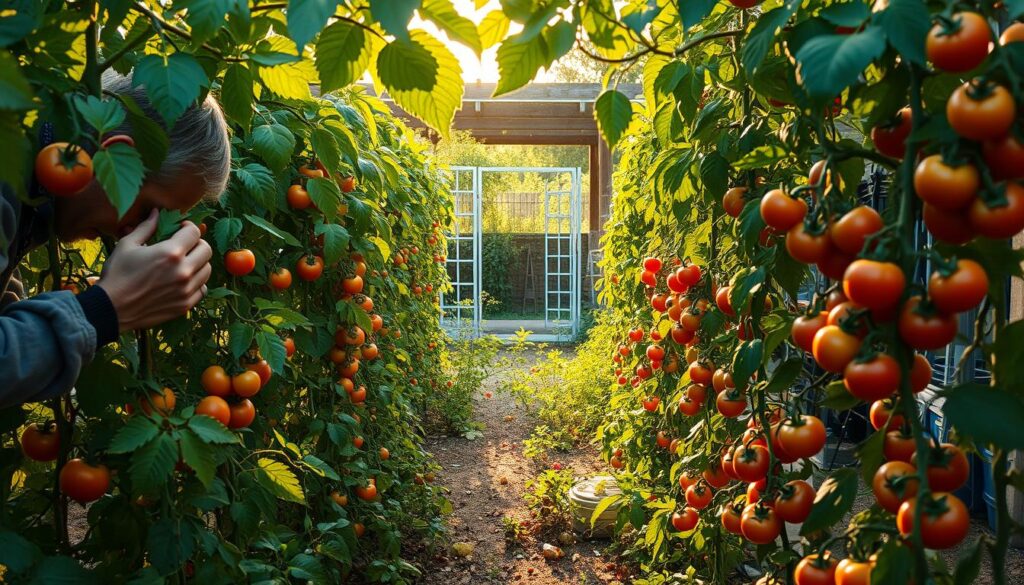
Environmental Stress Factors
Tomatoes are sensitive to environmental stresses such as extreme temperatures, drought, and excessive moisture. Ensuring consistent watering and providing shade during extreme heat can help mitigate these stresses.
Fruit Problems: Cracking, Blossom End Rot, and Cat-facing
Issues like fruit cracking, blossom end rot, and cat-facing can be distressing for gardeners. These problems are often related to watering inconsistencies or calcium deficiencies. Maintaining consistent soil moisture and ensuring adequate calcium can help prevent these issues.
By understanding and addressing these common challenges, gardeners can improve their chances of a successful organic tomato cultivation experience.
Conclusion: Harvesting and Enjoying Your Homegrown Tomatoes
Growing tomatoes at home can be a rewarding experience, providing you with a bountiful harvest of delicious homegrown tomatoes. By following the steps outlined in this guide, you’ve learned how to select the best varieties, prepare your soil, and care for your plants to achieve a successful crop.
When your tomatoes are fully ripe, it’s time to enjoy the fruits of your labor. Check the seed packet for specific guidance on the variety you’ve chosen, as some may have different ripening times. Homegrown tomatoes are perfect for salads, sauces, and sandwiches, offering superior flavor and nutritional value compared to store-bought alternatives.
Enjoy the satisfaction of growing tomatoes at home and savor the taste of your homegrown tomatoes. With practice and patience, you’ll become a seasoned tomato gardener, ready to share your bounty with friends and family.



